Thursday 8 December 2016
White: K. Nevols (134) - Black: P. Blundell (120)
This was the last competitive game before the Christmas/New year break and I was keen to end the new year on a high.
1. e4 c5
A change from 1. .. e5 which he played against me last time (Game Eight) so it is into the Closed Sicilian once again.
2. Nc3 Nc6
3. f4 e6
4. Nf3 Nd4?!
A surprise early second move with the knight. Perhaps better to continue development with 4. ..d5, 4. .. Nf6 or 4. .. Nge7.
5. d3 Nxf3
6. Qxf3 d6
The problem with 4. .. Nd4 is that White now has some central control and development whereas Black's pieces are all on the back row. White could now consider 7. Be3 with d4 to follow. Instead I decide to tuck the king away.
7. Be2 Bd7
8. O-O Bc6
With the queen and rook on the f-file, Black's king in the centre, and Black's delay of Nf6, then the
next move suggests itself.
9. f5 e5
If 9. .. exf5 10. Qxf5 Qd7 11. Qf2 - Black is unable to castle and White is preparing Be3 and d4.
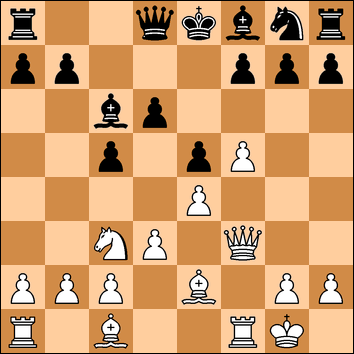
Now I considered 10. Nd5 Bxd5 11. exd5 but thought this just looked odd. I considered maybe Black could play 11. ... b5 to stop 12. c4 but then this walks into the brilliant 12. d4! and Black's centre is a struggle.
So instead I looked for better squares for the queen and king's bishop, and placing the queen on g3 holds up Black's kingside development.
10. Qg3 Nf6
11. Bf3 Rg8
Presumably to free the bishop. I too was thinking of freeing the other bishop and decided to move away from any Qb6 threats.
12. Kh1 Be7
13. a3 Kd7
Black concedes that he is unable to castle and so tries to improve the king safety. I think 13. .. g6 might have been an improvement. White's pieces are still a little disorganised.
But now that the Black king is committed, I can put together a plan. The kingside is not going anywhere and so I decide to open the game on the queenside.
14. Be3 b6
15. b4!
I want to create some open files and spaces around his king and try to exploit them with the rooks and bishops.
15. ... Qc7
16. bxc5
I did not like 16. b5 Bb7 which shuts the game down and reduces my attacking possibilities. I can use the fact that a black rook is busy defending the g7 pawn to get a queenside offensive going.
16. .... bxc5
17. Rfb1 Rab8
18. Rxb8 Qxb8
19. Rb1 Qc7
So I have got the open file and a clear edge - so what should I do next?
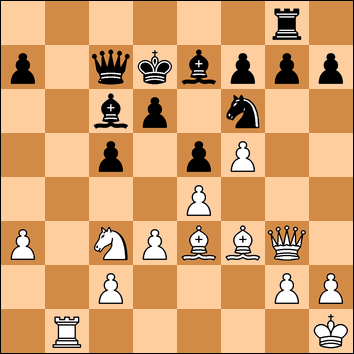
I did not consider 20. Nd5 but this wins material. If 20. .. Nxd5 21. exd5 then the bishop has to move.
If 21. ... Ba4?? then 22. f6! Bxf6 23. Qg4+ wins a piece.
If 21. ... Ba8 or Bb7 then 22. Qh3 Bf6 23. Qxh7 - pawn grabbing perhaps but they all count. Then maybe 23. ... Rb8 24. Rf1 preparing g4-g5. If Black then goes for some pawn grabbing with 24. .. Qa5 White has the flashy 25. Bh6 (25. ... gxh6 26. Qxf7+ Be7 27. f6) but after 25. .. c4! 26. Bxg7 Bxg7 27. Qxg7 Bxd5 there is still a lot of work to do.
Instead I decide to keep advancing on the queenside and the next move makes Nb5 an option.
20. a4 Qc8
At first I did not understand this but Black is reorganising his defences. The computer recommends 20. .. Kc8!? as an unusual way to defend the b7 square.
21. Qe1 Qa8
22. Rb3 Rb8
23. Qb1
Building up pressure again - I now had 14 minutes left for 12 moves - so ought to get a move on - while my opponent had 45 minutes. (Time was the usual 35 moves in 75 minutes and then 15 minutes each for the rest of the game).
23. ... Rxb3
24. Qxb3
Now I expected 24. .. Ke8 when I was considering 25. Nb5 - although 25. g4 would be more aggressive and keeping the initiative.
24. ...... Qb7?!
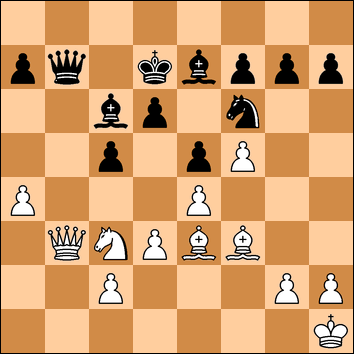
I don't know whether this was a pawn sacrifice or an oversight, but now I could see how I could grab a pawn and take the queens off.
25, Qxf7 Qb2
26. Qb3 Qxb3
27. cxb3
And now here we are at the ending. We both have two bishops and a knight and I have seven pawns to his six. So how do we win from here?
Part one of my plan is now to advance on the kingside where I have three pawns against two, use the white squared bishop to keep an eye on the b3 and d3 pawns, and try to create a space to infiltrate and exploit the black defences.
27. ... h6?
I think this is a mistake as it weakens the kingside where I am about to advance.
28. h4 Kc7
Another surprise - I had expected his king to go the other way, although here 28. ... Ke8 walks into 29. Nb5.
29. g4 Nh7
30. Bf2
Defending the h-pawn and preparing for the king's advance.
30. .... Kb7
31. Kg2 Ka6
32. Be1
To shut the door on any ideas of Ka5 which would lose a piece to Nd5+.
32. ... Nf8
Sitting still with 32. .... Bd8 might have been better but Black has a plan to re-route the knight over to the other side.
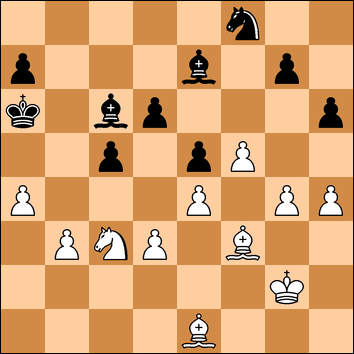
Now I picked up the bishop on e1 preparing to move it to d2 before realising that this loses the h-pawn. After hovering it in the air, I placed it on the f2 square instead. A wasted move when 33. Nd5 would have been a clear improvement.
33. Bf2 Nd7
34. Be1 Nb8
I was a bit lost what Black was planning now so just continued to advance. I could not help but think it was a mistake to have moved two pieces so far away from the area I was about to attack.
35. Kg3 Nd7
36. Bd2 Nb6
37. g5
And why not?
37. ... hxg5
38. hxg5 Nd7
Now the next step of the plan - I have broken a way through, so I must now advance my pieces into that gap and try to roll up the Black defences. His king looks very lonely over on the a6 square.
39. Bh5 Kb7
40. Bf7 Kb8
41. Kg4 Bb7
42. Kh5 Nf8
I think this is the move Black was relying on. The knight and bishop provide good defence.
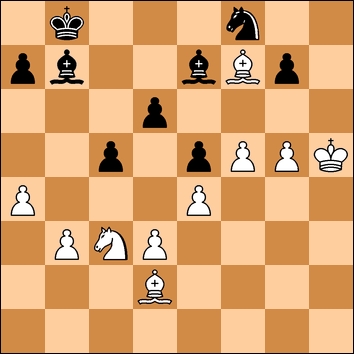
But now 43. f6! wins material. If 43. ... gxf6 44. g6 wins a piece and if 43. ..g6+ then simply 44. Bxg6 or 44. Kh6 Bd8 45. Kg7 Nd7 46. Be6.
43. Bc4?
I missed the chance, and do so again next move, and Black gets some breathing space.
43. ..... Kc8
44. Nd5? Bd8
45. a5
Without realising I had missed the chance, I could not see how I could break through, so decided to make some space on the other side.
45. .... Bc6
46. b4 cxb4
47. Bxb4 Kd7
Now I am trying to find good squares for the pieces for the final breakthrough and have the idea of bring the knight to c4. But Black has had enough of sitting around and allows the king to infiltrate to exchange a set of pawns.
48. Ne3 Nh7
49. Kg6 Nxg5
50. Kxg7 Kc7??
Black's king wanders off again which allows me the chance to win a piece. Staying on d7 was the better option.
51. f6 Bxf6
52. Kxf6
Now I am a clear piece ahead and, with Ke7 to come, the d-pawn cannot be protected.
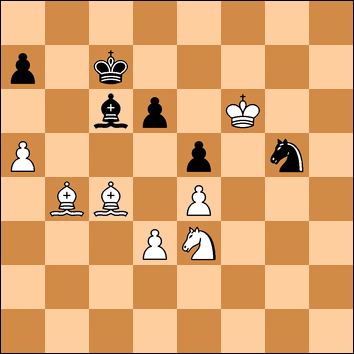
We were both now low on time and so Black decides to sacrifice his pieces for the pawns - a novel approached which very nearly worked.
52. .... Nxe4?!
53. dxe4 Bxe4
54. Ke6 Kd8
55. Bxd6 Bc6
56. Bc5 e4
57. Bxa7 Bb7
58. a6 Bc8
59. Kd6 Ke8
60. Bb5+ Kf7
61. Bd4 Bxc6
62. Bxc6
And now, with less than five minutes, I stopped writing down the moves.
I soon picked up the e-pawn which left me with three pieces to checkmate Black, but I managed to make a mess of it - the king kept wriggling free. At one point I thought I had checkmate but again he got free.
I then decided to just use the two bishops and leave the knight to lose a tempo and block stalemates, and eventually found the right plan - forcing the king into the corner. I was three moves away from checkmating when Black's flag fell. I had 19 seconds left.
Far too close but a good win nonetheless. My sixth win in a row and 12th unbeaten.
No comments:
Post a Comment